Interaction between the Cultural and Entertainment Industry and Urban Development in Xi’an: A Case Study
Abstract
1. Introduction
2. Materials and Methods
2.1. Research Area
2.2. Data Sources and Processing
2.2.1. Data Sources
- (1)
- Data on the CEI come from a list of point of interest (POI) data from 2000 to 2020 released by the official website of TianYanCha (https://www.tianyancha.com/). The POI attributes specifically include enterprise name, date of establishment, business status, address, and other information. Based on the available research results and the Classification of Culture and Related Industries (2018) released by the National Bureau of Statistics of China, the POIs of the CEI were divided into eight industry types: bars, cafés, cinemas, dance halls, tea bars, fitness centers, Internet cafés, and parks. The POIs were screened, cleaned, and classified. Finally, 4323 POIs were obtained.
- (2)
- Data on urban development come from the nighttime light data released by the National Centers for Environmental Information (https://www.ngdc.noaa.gov/) and the Colorado School of Mines’ academic department website (https://payneinstitute.mines.edu/eog/), including Defense Meteorological Satellite Program-Operational LinescanSystem (DMSP-OLS) data for 2000 and 2010 and National Polar-Orbiting Partnership—Visible Infrared Imaging Radiometer Suite (NPP-VIIRS) data for 2020. In this study, the stable light image composite of the nighttime light data was selected. The stable light image composite was created by further cleaning up the ephemeral light sources such as wildfires, lightning, and fishing boats. The pixel value of the stable light image composite represents the average of all light intensity values observed on cloud-free days in a calendar year from temporally stable sources such as cities, towns, villages, industrial sites, and persistent gas flares. The pixel value has 6-bit radiometric quantification levels, ranging from 0 to 63 [33]. Areas without cloud-free observations in a calendar year are indicated by the value of 255. The grid cell size of these image composites is 30 arc second (approximately 1 km), oversampled from the original DMSP-OLS smooth mode observations at a spatial resolution of 2.7 km [34].
2.2.2. Data Processing
2.3. Research Methods
2.3.1. Equal-Fan Analysis Method
2.3.2. Expansion Intensity Index
2.3.3. Coordination Model
3. Results
3.1. Interaction between CEI Expansion and Urban Expansion
3.1.1. Characteristics of CEI Expansion and Urban Expansion
3.1.2. Synchronization of CEI Expansion and Urban Expansion
3.2. Interaction between CEI Growth and Urban Growth
4. Discussion
4.1. Mechanism of the Influence of Urban Development on CEI
4.2. Mechanism of CEI Influence on Urban Development
4.3. Limitation and Prospects
5. Conclusions
- (1)
- The CEI and urban development in Xi’an are characterized by consistency and variability in external expansion. The CEI and urban development expanded in the northeast–southwest direction, but the synchronization of their expansion varied greatly in different directions. Economically underdeveloped regions may limit both the CEI and urban development, making it easier for both to reach a state of low-quality coordination. However, in most directions, the two developed at very different speeds, mainly because the expansion rate of the CEI was faster. In the early stage of urban development, the priority layout of parks and cinemas may be conducive to the shaping of cultural and entertainment space.
- (2)
- The CEI and urban development in Xi’an are characterized by “center-edge” internal coordination. The relationship between CEI growth and urban growth was coordinated. The closer to the downtown area, the more obvious the coordination between the two became. In the downtown area, the mature social and economic environment was conducive to the development of the CEI, and the development of the CEI drove the development of the city in the latter decade. However, in peripheral areas of the city, the development of the CEI needed to be driven by urban development. The CEI and urban development entered a period of rapid growth from 2010 to 2020, basically establishing their overall growth pattern from 2000 to 2020.
- (3)
- The CEI and urban development in Xi’an mutually promote each other. The urban functional pattern guides the CEI layout. Moreover, the CEI’s spatial pattern promotes the reconfiguration of urban space. Various functional patterns of cities attract different elements, such as human resources, capital, information, and policies, to gather and provide an environment for CEI development. The production of cultural and entertainment venues as a means of renewal reconstructs urban space and continuously improves a city’s spatial structure. Thus, the CEI and urban development interact to form a virtuous cycle.
Author Contributions
Funding
Data Availability Statement
Conflicts of Interest
References
- Xun, Y.; Shi, W.; Liu, T. Research on the Structural Characteristics of Entertainment Industrial Correlation in China: Based on Dual Perspective of Input-Output and Network Analysis. Complexity 2021, 2021, 6426123. [Google Scholar] [CrossRef]
- Hall, P. Creative cities and economic development. Urban Stud. 2000, 37, 639–649. [Google Scholar] [CrossRef]
- Evans, G. Creative Cities, Creative Spaces and Urban Policy. Urban Stud. 2009, 46, 1003–1040. [Google Scholar] [CrossRef]
- Landry, C. The Creative City: A Toolkit for Urban Innovators; Oxford University Press: Oxford, UK, 2000. [Google Scholar]
- Scott, A.J. The Cultural Economy of Cities: Essays on the Geography of Image-Producing Industries; SAGE Publications Ltd.: Thousand Oaks, CA, USA, 2000. [Google Scholar]
- Markusen, A. Urban development and the politics of a creative class: Evidence from a study of artists. Environ. Plan. A 2006, 38, 1921–1940. [Google Scholar] [CrossRef]
- Ren, X.; Sun, M. Artistic Urbanization: Creative Industries and Creative Control in Beijing. Int. J. Urban Reg. Res. 2012, 36, 504–521. [Google Scholar] [CrossRef]
- Webster, D.; Muller, L.; Cai, J. The emerging cultural economy in Chinese cities: Early dynamics. Int. Dev. Plan. Rev. 2011, 33, 343–369. [Google Scholar] [CrossRef]
- Fan, T.; Xue, D. Spatial correlation of cultural industry and tourism industry in Shaanxi Province, China: LISA analysis based on coordination model. Asia Pac. J. Tour. Res. 2020, 25, 967–980. [Google Scholar] [CrossRef]
- Chambers, E. Tourism and Culture: An Applied Perspective; State University of New York Press: Albany, NY, USA, 1997. [Google Scholar]
- Hughes, G. The cultural construction of sustainable tourism. Tour. Manag. 1995, 16, 49–59. [Google Scholar] [CrossRef]
- Wang, X.; Xiao, F.; Zhang, Y.; Yin, L.; Lesi, M.; Guo, B.; Zhao, Y. Thirty-year expansion of construction land in Xi’an: Spatial pattern and potential driving factors. Geol. J. 2018, 53, 309–321. [Google Scholar] [CrossRef]
- Li, Y.; Xue, D.; Zhang, P.; Song, Y. Spatial structure and accessibility mode of entertainment industries in Xian City. Prog. Geogr. 2022, 41, 797–811. [Google Scholar] [CrossRef]
- de Santana Ribeiro, L.C.; Carneiro Rios Lopes, T.H.; Ferreira Neto, A.B.; dos Santos, F.R. Cultural employment growth in Brazilian municipalities. J. Cult. Econ. 2020, 44, 605–624. [Google Scholar] [CrossRef]
- Scott, A.J. A World in Emergence: Cities and Regions in the 21st Century; Edward Elgar: Cheltenham, UK; New York, NY, USA, 2012. [Google Scholar]
- Su, W. From culture for the people to culture for profit: The PRC’s journey toward a cultural industries approach. Int. J. Cult. Policy 2015, 21, 513–528. [Google Scholar] [CrossRef]
- Grodach, C. Mapping the arts: Industry concentrations, distribution, and change in the US, 1980–2010. Int. J. Cult. Policy 2016, 22, 353–375. [Google Scholar] [CrossRef]
- Currid, E.; Williams, S. Two Cities, Five Industries: Similarities and Differences within and between Cultural Industries in New York and Los Angeles. J. Plan. Educ. Res. 2010, 29, 322–335. [Google Scholar] [CrossRef]
- Deng, L.; Wu, J. A Study on the Spatial Evolution of Public Entertainment Space in Modern Shanghai (1843–1949). China City Plan. Rev. 2018, 27, 62–72. [Google Scholar]
- Florida, R. Cities and the Creative Class; Routledge: London, UK, 2004. [Google Scholar]
- He, D.; Chen, Z.; Ai, S.; Zhou, J.; Lu, L.; Yang, T. The Spatial Distribution and Influencing Factors of Urban Cultural and Entertainment Facilities in Beijing. Sustainability 2021, 13, 12252. [Google Scholar] [CrossRef]
- Cole, A. Distant neighbours: The new geography of animated film production in Europe. Reg. Stud. 2008, 42, 891–904. [Google Scholar] [CrossRef]
- Markusen, A.; Schrock, G. The artistic dividend: Urban artistic specialisation and economic development implications. Urban Stud. 2006, 43, 1661–1686. [Google Scholar] [CrossRef]
- Zhu, Y. An Economic Model for Studying the Role of Cultural Industries on Social Development in Cross-border Contexts. Emerg. Mark. Financ. Trade 2020, 56, 1581–1600. [Google Scholar] [CrossRef]
- Betlej, A.; Kacerauskas, T. Urban Creative Sustainability: The Case of Lublin. Sustainability 2021, 13, 4072. [Google Scholar] [CrossRef]
- He, S. The creative spatio-temporal fix: Creative and cultural industries development in Shanghai, China. Geoforum 2019, 106, 310–319. [Google Scholar] [CrossRef]
- Yin, M.; Derudder, B. Geographies of cultural industries across the global urban system. Geogr. Compass 2021, 15, e12564. [Google Scholar] [CrossRef]
- Hall, P. The World Cities; Weidenfeld and Nicolson: London, UK, 1966. [Google Scholar]
- Florida, R. The Rise of the Creative Class; Basic Books: New York, NY, USA, 2002. [Google Scholar]
- Waitt, G.; Gibson, C. Creative Small Cities: Rethinking the Creative Economy in Place. Urban Stud. 2009, 46, 1223–1246. [Google Scholar] [CrossRef]
- McGregor, A.; Gibson, C. Musical work in a university town: The shifting spaces and practices of DJs in Dunedin. Asia Pac. Viewp. 2009, 50, 277–288. [Google Scholar] [CrossRef]
- Gibson, C. Guest EditorialCreative Geographies: Tales from the ‘margins’. Aust. Geogr. 2010, 41, 1–10. [Google Scholar] [CrossRef]
- Doll, C. CIESIN Thematic Guide to Night-time Light Remote Sensing and Its Applications. 2008. Available online: https://www.researchgate.net/publication/266160887_CIESIN_Thematic_Guide_to_Night-time_Light_Remote_Sensing_and_its_Applications (accessed on 14 June 2022).
- Small, C.; Elvidge, C.D.; Balk, D.; Montgomery, M. Spatial scaling of stable night lights. Remote Sens. Environ. 2011, 115, 269–280. [Google Scholar] [CrossRef]
- Croft, T.A. Nighttime images of the earth from space. Sci. Am. 1978, 239, 86–98. [Google Scholar] [CrossRef]
- Baugh, K.E.; Elvidge, C.D.; Tilottama, G.; Ziskin, D. Development of a 2009 Stable Lights Product using DMSP-OLS data. Proc. Asia-Pac. Adv. Netw. 2010, 30, 114–130. [Google Scholar] [CrossRef]
- Liu, Z.; He, C.; Zhang, Q.; Huang, Q.; Yang, Y. Extracting the dynamics of urban expansion in China using DMSP-OLS nighttime light data from 1992 to 2008. Landsc. Urban Plan. 2012, 106, 62–72. [Google Scholar] [CrossRef]
- Wei, Y.; Liu, H.; Song, W.; Yu, B.; Xiu, C. Normalization of time series DMSP-OLS nighttime light images for urban growth analysis with Pseudo Invariant Features. Landsc. Urban Plan. 2014, 128, 1–13. [Google Scholar] [CrossRef]
- Zhang, Q.; Seto, K.C. Mapping urbanization dynamics at regional and global scales using multi-temporal DMSP/OLS nighttime light data. Remote Sens. Environ. 2011, 115, 2320–2329. [Google Scholar] [CrossRef]
- Xie, Y.; Weng, Q. Updating urban extents with nighttime light imagery by using an object-based thresholding method. Remote Sens. Environ. 2016, 187, 1–13. [Google Scholar] [CrossRef]
- Zhou, C.; Gong, H.; Zhang, Y.; Warner, T.A.; Wang, C. Spatiotemporal Evolution of Land Subsidence in the Beijing Plain 2003–2015 Using Persistent Scatterer Interferometry (PSI) with Multi-Source SAR Data. Remote Sens. 2018, 10, 552. [Google Scholar] [CrossRef]
- Shang, Z.; Zhang, X.; Zhou, X. Study on urban spatial expansion and external morphology evolution based on RS/GIS: A case of Huai’an City. Econ. Geogr. 2012, 32, 64–70. [Google Scholar]
- Chen, J.; Gao, J.; Chen, W. Urban land expansion and the transitional mechanisms in Nanjing, China. Habitat Int. 2016, 53, 274–283. [Google Scholar] [CrossRef]
- Ye, Q.; Mo, Z.; Xu, Y. The expansion and driving forces of the functional space land: A case study of Changsha from 1979 to 2014. Geogr. Res. 2019, 38, 1063–1079. [Google Scholar]
- Yang, L.; Wang, Y.; Bai, Q.; Han, S. Urban Form and Travel Patterns by Commuters: Comparative Case Study of Wuhan and Xi’an, China. J. Urban Plan. Dev. 2018, 144. [Google Scholar] [CrossRef]
- Liu, Y.; Li, H.; Li, W.; Wang, S. Renovation priorities for old residential districts based on resident satisfaction: An application of asymmetric impact-performance analysis in Xi’an, China. PLoS ONE 2021, 16, e0254372. [Google Scholar] [CrossRef]
- Yuan, C.; Duan, Y.; Mao, X.; Ma, N.; Zhao, J. Impact of the mixed degree of urban functions on the taxi travel demand. PLoS ONE 2021, 16, e0247431. [Google Scholar] [CrossRef]
- de la Luz Hernandez-Flores, M.; Otazo-Sanchez, E.M.; Galeana-Pizana, M.; Roldan-Cruz, E.I.; Razo-Zarate, R.; Gonzalez-Ramirez, C.A.; Galindo-Castillo, E.; Gordillo-Martinez, A.J. Urban driving forces and megacity expansion threats. Study case in the Mexico City periphery. Habitat Int. 2017, 64, 109–122. [Google Scholar] [CrossRef]
- Liu, L.; Liu, J.; Liu, Z.; Xu, X.; Wang, B. Analysis on the Spatio-Temporal Characteristics of Urban Expansion and the Complex Driving Mechanism: Taking the Pearl River Delta Urban Agglomeration as a Case. Complexity 2020, 2020, 8157143. [Google Scholar] [CrossRef]
- Osman, T.; Divigalpitiya, P.; Arima, T. Driving factors of urban sprawl in Giza Governorate of Greater Cairo Metropolitan Region using AHP method. Land Use Policy 2016, 58, 21–31. [Google Scholar] [CrossRef]
- Xue, D.; Wan, S.; Ma, B.; Chen, R. Spatial Agglomeration of Cultural Industry of Xi’an City Based on Urban Functional Pattern. Sci. Geogr. Sin. 2019, 39, 750–760. [Google Scholar]
- Shi, L.; Yu, B. Eco-Industrial Parks from Strategic Niches to Development Mainstream: The Cases of China. Sustainability 2014, 6, 6325–6331. [Google Scholar] [CrossRef]
- Lefika, P.T.; Mearns, M.A. Adding knowledge cafes to the repertoire of knowledge sharing techniques. Int. J. Inf. Manag. 2015, 35, 26–32. [Google Scholar] [CrossRef]
- Gong, Y. Correctly Interpreting the Relationship between Two Historical Periods before and after the Reform and Opening Up in China. Int. Crit. Thought 2022, 12, 271–286. [Google Scholar] [CrossRef]
- Zhang, X.; Sun, G. The Analysis of the Time and Space on the Development of Tour ism Economy in Xi’an. J. Shangluo Univ. 2006, 2006, 50–55. [Google Scholar]
- Benton-Short, L. Rethinking urban parks: Public space and cultural diversity. Ann. Assoc. Am. Geogr. 2006, 96, 853–855. [Google Scholar] [CrossRef]
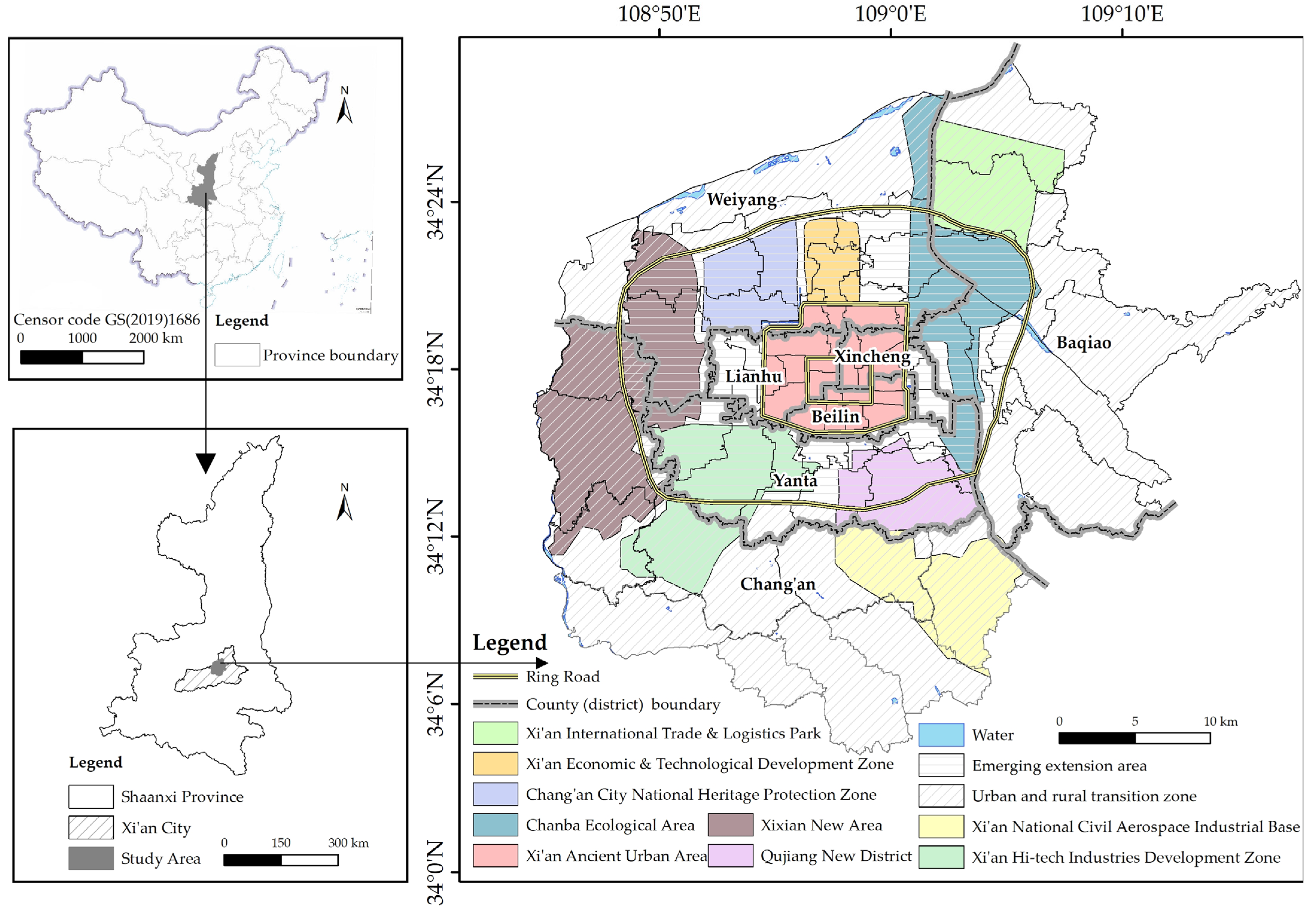
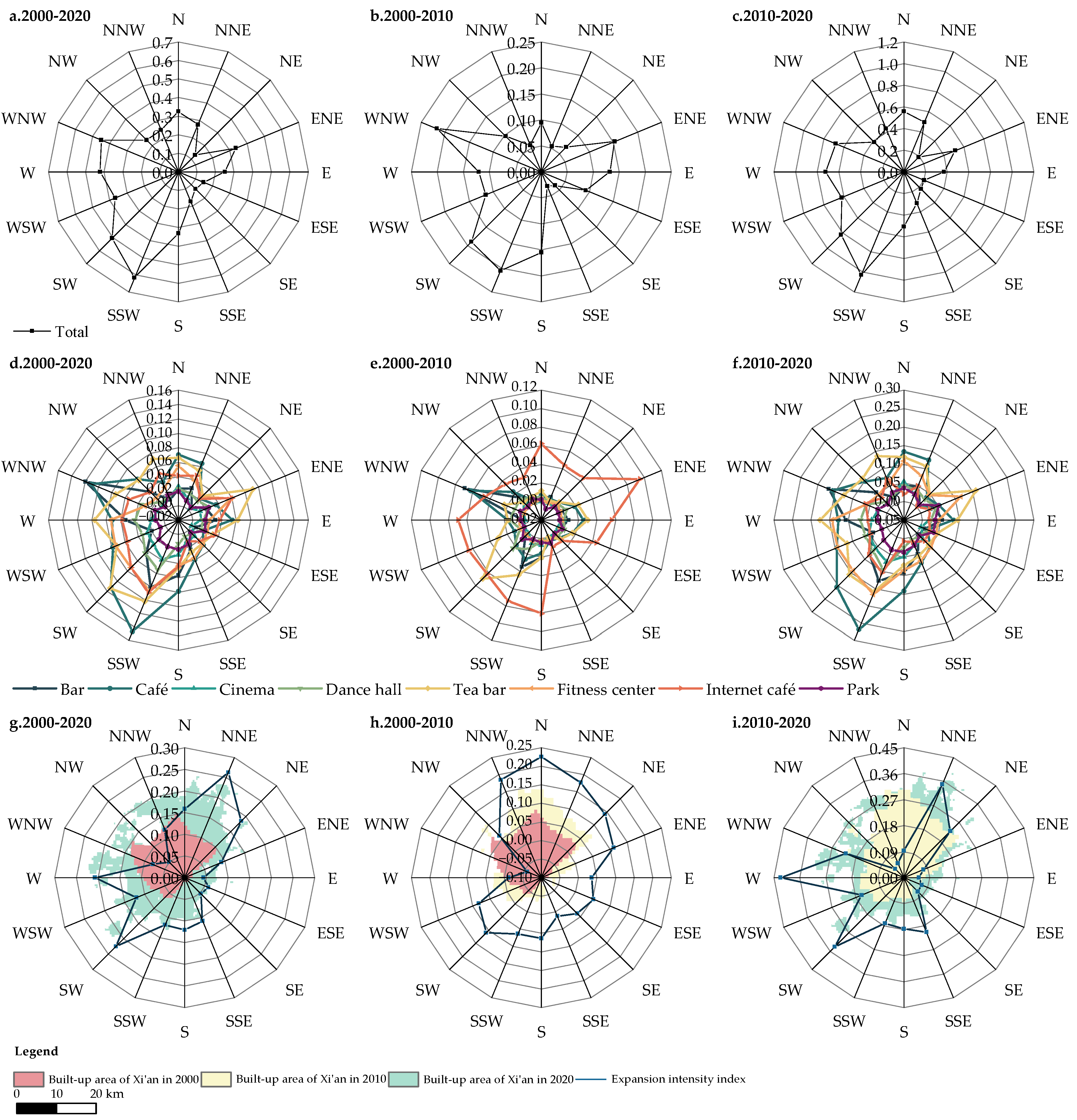
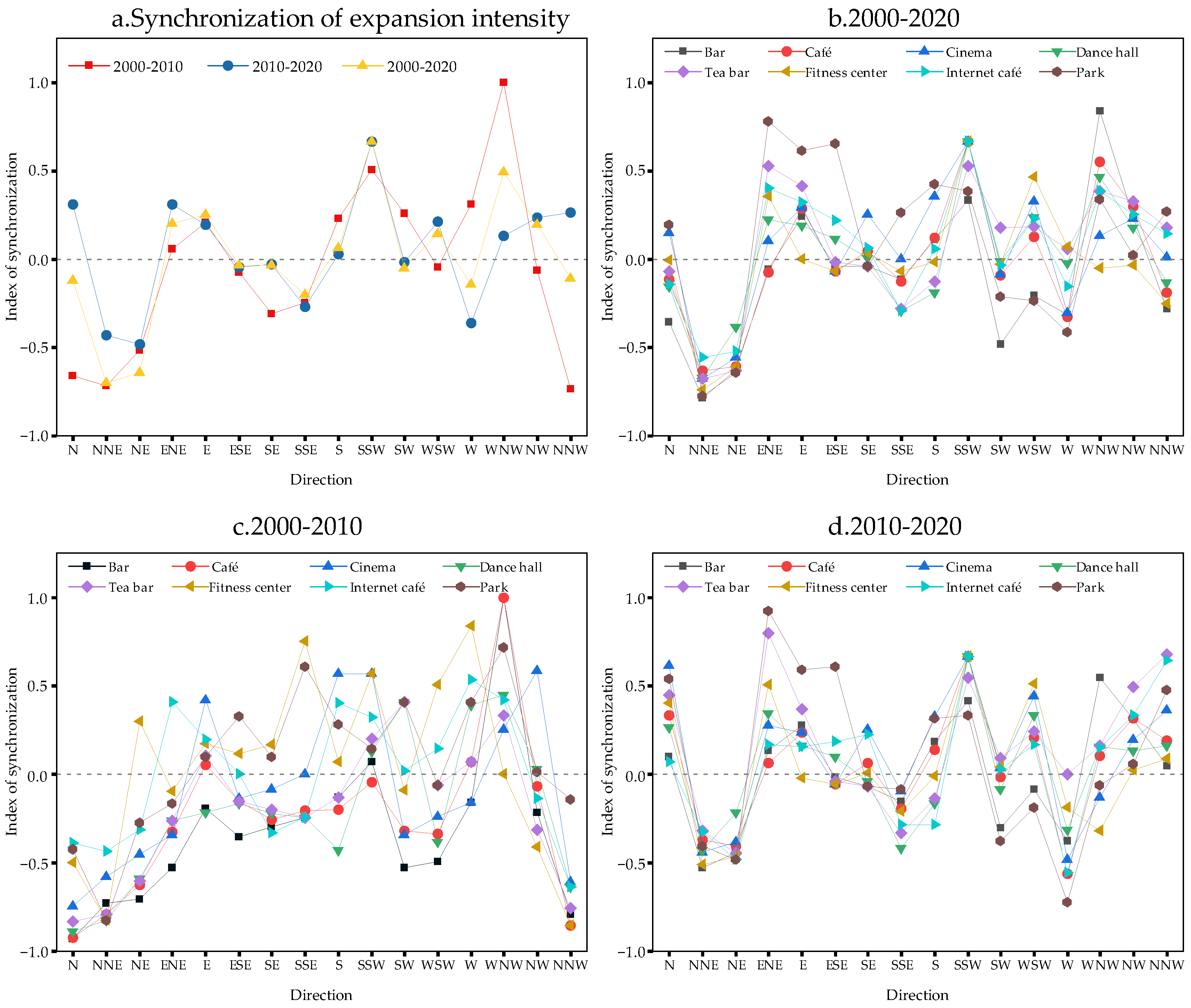
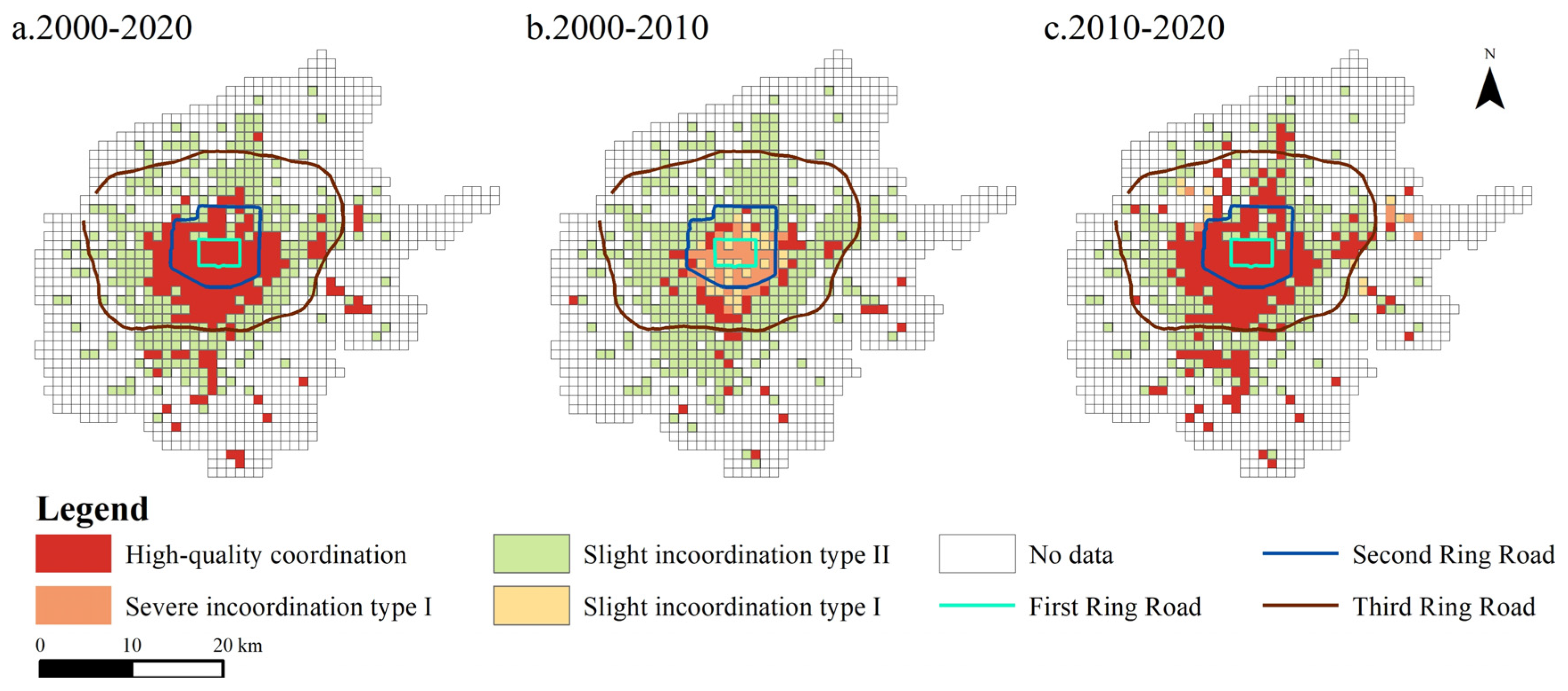
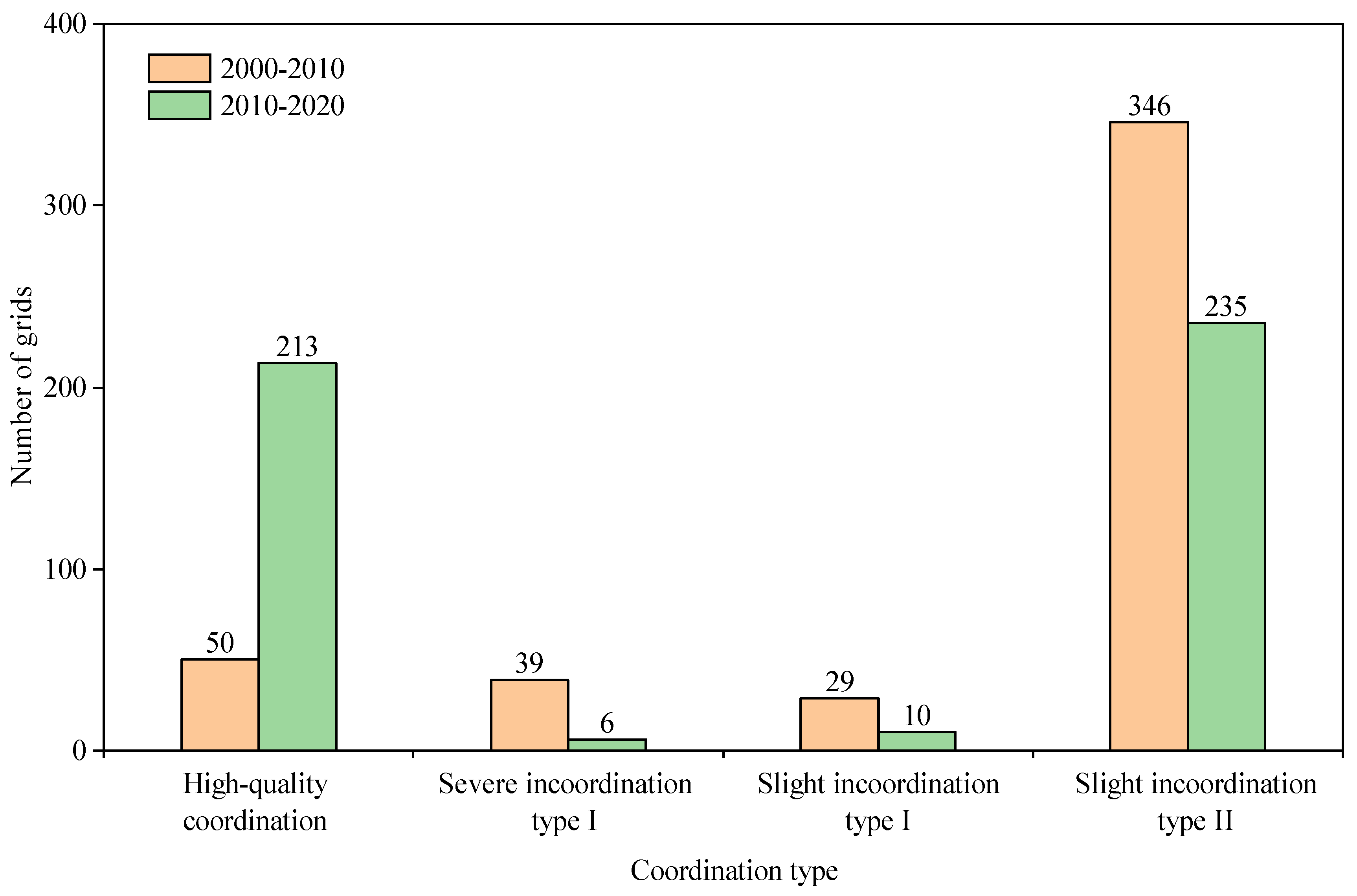
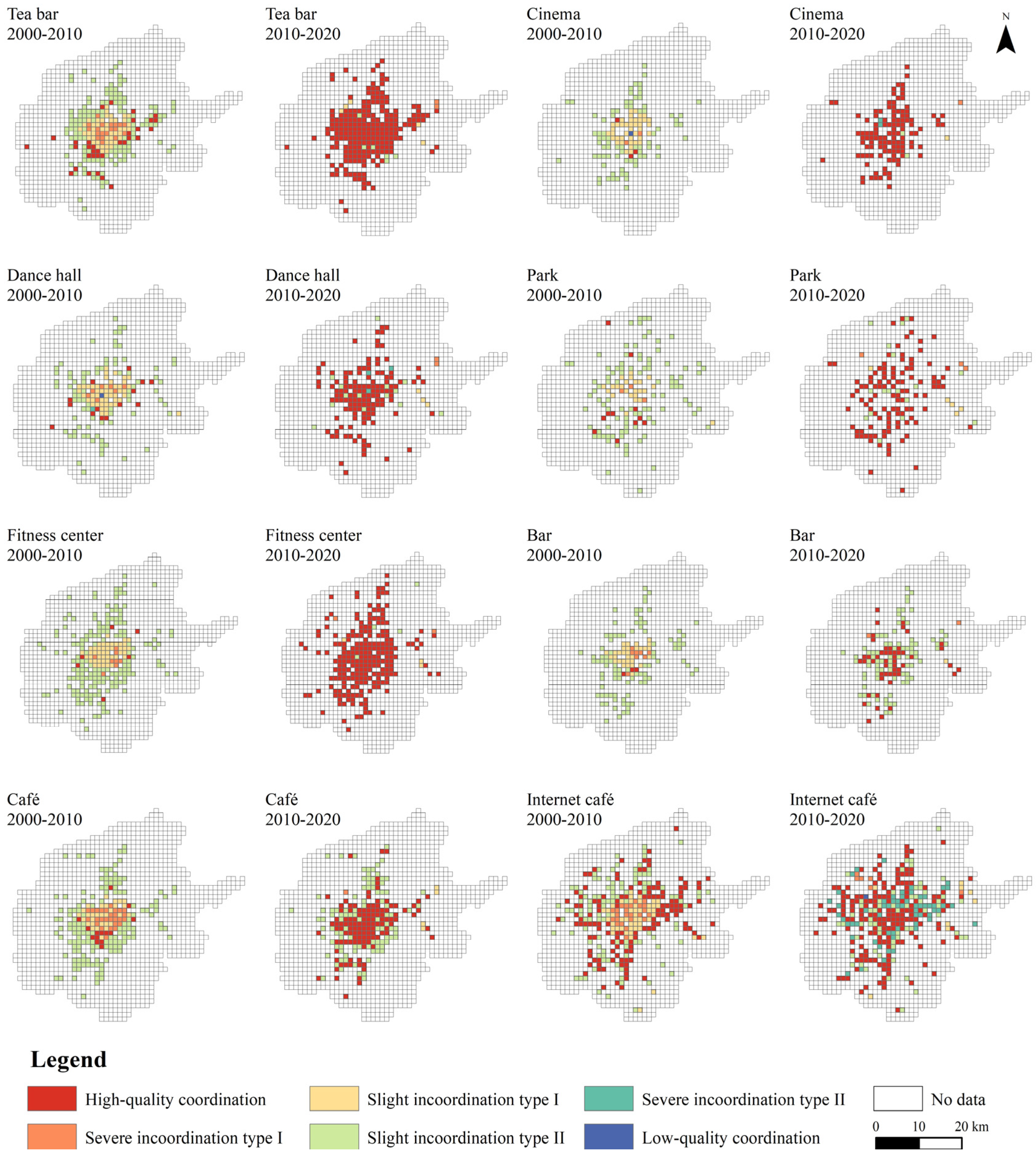

| Type | Conditions | Meaning |
|---|---|---|
| High-quality coordination | The number of POIs and the value of nighttime light are increasingly coordinated. The CEI and urban development are improving in a synergistic manner. | |
| Severe incoordination Type I | The number of POIs is poorly coordinated with the value of nighttime light. The CEI is growing faster than the urban area. | |
| Slight incoordination Type I | The number of POIs is slightly uncoordinated with the value of nighttime light. The CEI is growing faster than the urban area. | |
| Slight incoordination Type Ⅱ | The number of POIs is slightly uncoordinated with the value of nighttime light. The city is growing faster than the CEI. | |
| Severe incoordination Type Ⅱ | The number of POIs is poorly coordinated with the value of nighttime light. The city is growing faster than the CEI. | |
| Low-quality coordination | The number of POI and the value of nighttime light decline in coordination. The CEI and urban development are in a state of synergistic decline. |
| Period | Bar | Café | Cinema | Dance Hall | Tea Bar | Fitness Center | Internet Café | Park |
|---|---|---|---|---|---|---|---|---|
| 2000–2020 | 0.0351 | 0.0643 | 0.0166 | 0.0237 | 0.0638 | 0.0452 | 0.0459 | 0.0145 |
| 2000–2010 | 0.0111 | 0.0166 | 0.0014 | 0.0080 | 0.0198 | 0.0025 | 0.0519 | 0.0022 |
| 2000–2020 | 0.0591 | 0.1119 | 0.0318 | 0.0395 | 0.1079 | 0.0879 | 0.0399 | 0.0267 |
Disclaimer/Publisher’s Note: The statements, opinions and data contained in all publications are solely those of the individual author(s) and contributor(s) and not of MDPI and/or the editor(s). MDPI and/or the editor(s) disclaim responsibility for any injury to people or property resulting from any ideas, methods, instructions or products referred to in the content. |
© 2023 by the authors. Licensee MDPI, Basel, Switzerland. This article is an open access article distributed under the terms and conditions of the Creative Commons Attribution (CC BY) license (https://creativecommons.org/licenses/by/4.0/).
Share and Cite
Yang, H.; Xue, D.; Li, H.; Cai, X.; Ma, Y.; Song, Y. Interaction between the Cultural and Entertainment Industry and Urban Development in Xi’an: A Case Study. Land 2023, 12, 1445. https://doi.org/10.3390/land12071445
Yang H, Xue D, Li H, Cai X, Ma Y, Song Y. Interaction between the Cultural and Entertainment Industry and Urban Development in Xi’an: A Case Study. Land. 2023; 12(7):1445. https://doi.org/10.3390/land12071445
Chicago/Turabian StyleYang, He, Dongqian Xue, Hailing Li, Xinmeng Cai, Yanyan Ma, and Yongyong Song. 2023. "Interaction between the Cultural and Entertainment Industry and Urban Development in Xi’an: A Case Study" Land 12, no. 7: 1445. https://doi.org/10.3390/land12071445
APA StyleYang, H., Xue, D., Li, H., Cai, X., Ma, Y., & Song, Y. (2023). Interaction between the Cultural and Entertainment Industry and Urban Development in Xi’an: A Case Study. Land, 12(7), 1445. https://doi.org/10.3390/land12071445









